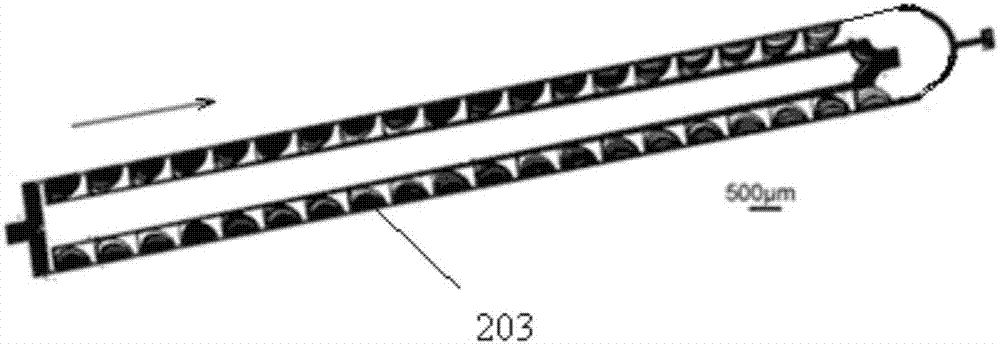Rapid purification device and rapid purification method for pathogenic bacteria in sputum sample
A pathogenic and rapid technology, applied in the field of medical diagnosis, can solve the problems of low separation efficiency and cannot meet the purification of pathogenic bacteria, etc., and achieves the effects of fast flow rate, convenient operation and simple preparation.
- Summary
- Abstract
- Description
- Claims
- Application Information
AI Technical Summary
Problems solved by technology
Method used
Image
Examples
Embodiment 1
[0038] Example 1 Chip structure and preparation
[0039] see figure 1 , the rapid purification device includes a microfluidic chip with an upper, middle and lower three-layer structure. The middle-layer chip 2 is provided with a main channel 203, a waste liquid collection channel 202 and a pathogenic bacteria collection channel 201; in this embodiment, a string structure composed of 8 series units and 12 pathogenic bacteria collection channels are arranged on the middle-layer chip 2. The like structure and the pathogen collection channel are arranged in parallel. One end of the upper chip 1 is provided with a liquid inlet hole 101, and the other end is provided with a pathogenic bacteria collection hole 102 and a waste liquid collection hole 103. The liquid inlet hole communicates with one end of the string structure of the separation unit, and the pathogenic bacteria collection hole In communication with the pathogenic bacteria collection channel, the waste liquid collectio...
Embodiment 2
[0047] Example 2: Use of chips and detection of separation efficiency
[0048] KYSE30-GFP cells and red light-labeled bacteria T23101-cherry were used to simulate exfoliated cells and pathogenic bacteria in sputum, which were mixed in a certain quantity ratio, and the separation efficiency of cells and bacteria was detected by rapid purification device chip separation. The specific steps are: trypsin digestion and stable transfection of GFP esophageal cancer cells KYSE30-GFP (green light), add 10% FBS RPM1640 medium to stop, centrifuge at 1000 rpm for 5 min, remove the supernatant, add PBS containing 4% fetal bovine serum (PH= 7.4), cell count, adjust cell concentration 0.5-1X10 6 pcs / ml. Pick the red-marked bacteria T23101-cherry into 2 ml of LB medium (AMP+) and culture at 37°C at 200 rpm overnight, centrifuge at 4000 rpm for 5 min, remove the supernatant, add PBS to vortex to suspend the bacteria, dilute the bacterial solution twice, and count the bacteria.
[0049] Take ...
Embodiment 3
[0053] Example 3: Detection of separation efficiency of sputum samples
[0054] After the sputum samples were liquefied by the Saccomanno-DTT method, the bacteria BW25113 (GFP+) was added and then passed into the device for rapid purification of pathogenic bacteria in the sputum samples for separation. The operation method is the same as that of Example 2. After the liquefied sputum was separated, Hoechst 33342 (100×) was added for staining for 10 min, centrifuged at 3000 rpm for 3 min, washed once with PBS, suspended in 1 / 50 volume of PBS, and 1 μl was dropped on a glass slide. The performance of the analysis chip to separate cells and bacteria from liquefied sputum, see Image 6 . At the same time, the GFP gene was used to represent bacteria, and the human BTF gene was used to represent cells. RT-PCR was performed on the original and purified collection samples to detect and analyze the separation efficiency of cells and bacteria in sputum samples.
[0055] GFP primer (PC...
PUM
| Property | Measurement | Unit |
|---|---|---|
| The inside diameter of | aaaaa | aaaaa |
Abstract
Description
Claims
Application Information
 Login to View More
Login to View More - Generate Ideas
- Intellectual Property
- Life Sciences
- Materials
- Tech Scout
- Unparalleled Data Quality
- Higher Quality Content
- 60% Fewer Hallucinations
Browse by: Latest US Patents, China's latest patents, Technical Efficacy Thesaurus, Application Domain, Technology Topic, Popular Technical Reports.
© 2025 PatSnap. All rights reserved.Legal|Privacy policy|Modern Slavery Act Transparency Statement|Sitemap|About US| Contact US: help@patsnap.com



